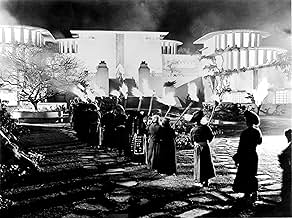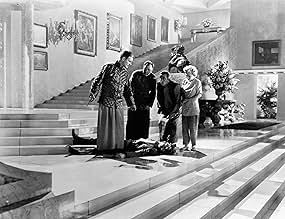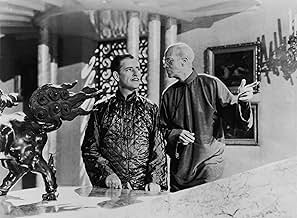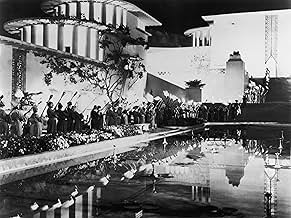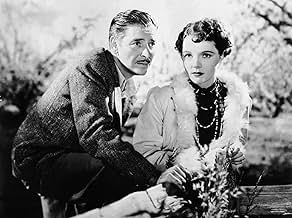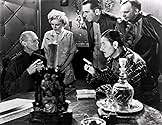IMDb RATING
7.6/10
15K
YOUR RATING
When a revered diplomat's plane is diverted and crashes in the peaks of Tibet, he and the other survivors are guided to an isolated monastery at Shangri-La, where they wrestle with the invit... Read allWhen a revered diplomat's plane is diverted and crashes in the peaks of Tibet, he and the other survivors are guided to an isolated monastery at Shangri-La, where they wrestle with the invitation to stay.When a revered diplomat's plane is diverted and crashes in the peaks of Tibet, he and the other survivors are guided to an isolated monastery at Shangri-La, where they wrestle with the invitation to stay.
- Director
- Writers
- Stars
- Won 2 Oscars
- 6 wins & 6 nominations total
Norman Ainsley
- Embassy Club Steward
- (uncredited)
Chief John Big Tree
- Porter
- (uncredited)
Wyrley Birch
- Missionary
- (uncredited)
Beatrice Blinn
- Passenger
- (uncredited)
Hugh Buckler
- Lord Gainsford
- (uncredited)
Sonny Bupp
- Boy Being Carried to Plane
- (unconfirmed)
- (uncredited)
John Burton
- Wynant
- (uncredited)
Tom Campbell
- Porter
- (uncredited)
Matthew Carlton
- Pottery Maker
- (uncredited)
- Director
- Writers
- All cast & crew
- Production, box office & more at IMDbPro
Featured reviews
I watched this film for the first time as a 10 year old and its effects on my willingness to be a optimistic idealist have always been led by my memories of this hope inspiring tribute to the need for the human being to find Heaven in this life. Perhaps Lost Horizon could have been that spark that enabled me to find just that. Like all films from another era do not judge this film for its apparent imperfections, rather for what it offered the audiences of that time (1937), hope that all would be well when man would recognize that his time is always better spent broadening his horizons of understanding. Frank Capra's guides his audiences through danger and turmoil to that place which dreams are made of, when we all make the effort to make it happen.
I think I was about seven or eight years old when I first saw this film, and has always lingered in the back of my mind. This is pure movie magic of a rare kind, and it is surprising how well it holds up today. The story is handled with just the right balance of seriousness and humour, with fine performances throughout, and the timeless message it sends is truly profound. The middle part may be lacking a bit in pacing, but it is a minor quibble, since this, for my money, is a masterpiece. And it still looks great, with impressive set design and an abundance of atmosphere. The finale is simply sublime, and stays in the mind for a long time afterwards, one of my favorite movie moments of all time. A movie everyone should see.
Frank Capra classic about a group of British citizens, led by diplomat Robert Conway (Ronald Colman), who flee a rebellion in China only to have their plane crash in the Himalayas. They are taken to Shangri-La, a magical place isolated in the mountains where people can leave behind the worries of civilization. They learn they will live for hundreds of years there but only if they never leave. The world-weary Conway is intrigued by the promise of this utopia but not everyone in his group feels the same way.
It's an ambitious undertaking for Capra, who made no other movies on the scale of this one (or with the budget). The costumes and Art Deco sets are beautiful. Great script from Robert Riskin, adapted from James Hilton's novel. Lovely, haunting score from Dimitri Tiomkin. Ronald Colman, an exceptional actor who never did a bad job that I've seen, gives a moving, sincere performance that ranks among the best of his impressive career. Sam Jaffe is also excellent in his small but important role as the High Lama. The rest of the wonderful cast includes John Howard, Jane Wyatt, Edward Everett Horton, H.B. Warner, Isabel Jewell, and Thomas Mitchell (the first of four movies he did with Capra). Jane Wyatt's swimming scene is probably the sexiest thing she ever did on film. The opening scenes are exciting and the climax is powerful. The middle of the film is where many people complain that it's slow or that it loses focus. I admit there is a chunk of the middle of the film, dealing with Colman and Wyatt falling in love, as well as everyone adjusting (or not adjusting) to Shangri-La that drags just a bit. But I never felt bored and I don't think it derails the film at all. The dialogue and performances in these scenes is still great. The original cut ran much longer and I can only imagine whether that version would be better or worse. As it is, seven minutes of footage is still missing from the current version. The dialogue for these scenes is intact, with production stills in place of the missing footage.
It's escapism, pure and simple. Many viewers will poke holes in the idea and philosophy behind Shangri-La, calling it naive and childish. Perhaps they're right; perhaps the cold, cynical reality of selfish human nature means such a utopia is impossible. But the thing about most of Frank Capra's films, and why he is probably my favorite director ever, was that he believed in telling uplifting, optimistic stories about us helping each other overcome our baser nature; that good can triumph over evil and there are such things as happy endings. While Lost Horizon is not really one of his "Capra-corn" movies, I think the basic Capra elements are still there, right down to the final shot. Most other directors would have likely gone for the sad or tragic ending, but Capra gives us one that is hopeful.
It's an ambitious undertaking for Capra, who made no other movies on the scale of this one (or with the budget). The costumes and Art Deco sets are beautiful. Great script from Robert Riskin, adapted from James Hilton's novel. Lovely, haunting score from Dimitri Tiomkin. Ronald Colman, an exceptional actor who never did a bad job that I've seen, gives a moving, sincere performance that ranks among the best of his impressive career. Sam Jaffe is also excellent in his small but important role as the High Lama. The rest of the wonderful cast includes John Howard, Jane Wyatt, Edward Everett Horton, H.B. Warner, Isabel Jewell, and Thomas Mitchell (the first of four movies he did with Capra). Jane Wyatt's swimming scene is probably the sexiest thing she ever did on film. The opening scenes are exciting and the climax is powerful. The middle of the film is where many people complain that it's slow or that it loses focus. I admit there is a chunk of the middle of the film, dealing with Colman and Wyatt falling in love, as well as everyone adjusting (or not adjusting) to Shangri-La that drags just a bit. But I never felt bored and I don't think it derails the film at all. The dialogue and performances in these scenes is still great. The original cut ran much longer and I can only imagine whether that version would be better or worse. As it is, seven minutes of footage is still missing from the current version. The dialogue for these scenes is intact, with production stills in place of the missing footage.
It's escapism, pure and simple. Many viewers will poke holes in the idea and philosophy behind Shangri-La, calling it naive and childish. Perhaps they're right; perhaps the cold, cynical reality of selfish human nature means such a utopia is impossible. But the thing about most of Frank Capra's films, and why he is probably my favorite director ever, was that he believed in telling uplifting, optimistic stories about us helping each other overcome our baser nature; that good can triumph over evil and there are such things as happy endings. While Lost Horizon is not really one of his "Capra-corn" movies, I think the basic Capra elements are still there, right down to the final shot. Most other directors would have likely gone for the sad or tragic ending, but Capra gives us one that is hopeful.
"I believe it because I want to believe it". This one line speaks volumes about what the movie (and the original novel) was trying to say. The concept of Shangri-La, a place where people work and live in peaceful harmony, is as relevant today as it was in the post-World War I era that James Hilton wrote 'Lost Horizon', where the world was still in turmoil following a devastating war and another was on its way.
In these days of war, humanitarian devastation and disease, how many people are there who dream of getting away from it all and living out their lives in a remote paradise just like Shangri-La? The High Lama's words to Conway resonate strongly even today.
"Look at the world today. Is there anything more pitiful? What madness there is! What blindness! What unintelligent leadership! A scurrying mass of bewildered humanity, crashing headlong against each other, propelled by an orgy of greed and brutality." On a more cinematographic note, the movie is visually stunning in an age before CGI and astronomical budgets. The beauty of Shangri-La, the stunning mountain landscapes and the overall settings of the movie make us believe that such a wonderful place can exist. All the actors are commendable in their portrayals (though some characters are different to those in the original novel) and their interaction with each other add a real sparkle to the movie.
'Lost Horizon' is a beautiful adaptation of James Hilton's masterpiece and captures the very feeling of the novel and I would highly recommend it to anyone who has ever dreamed of escaping from the hectic world in which we live.
In these days of war, humanitarian devastation and disease, how many people are there who dream of getting away from it all and living out their lives in a remote paradise just like Shangri-La? The High Lama's words to Conway resonate strongly even today.
"Look at the world today. Is there anything more pitiful? What madness there is! What blindness! What unintelligent leadership! A scurrying mass of bewildered humanity, crashing headlong against each other, propelled by an orgy of greed and brutality." On a more cinematographic note, the movie is visually stunning in an age before CGI and astronomical budgets. The beauty of Shangri-La, the stunning mountain landscapes and the overall settings of the movie make us believe that such a wonderful place can exist. All the actors are commendable in their portrayals (though some characters are different to those in the original novel) and their interaction with each other add a real sparkle to the movie.
'Lost Horizon' is a beautiful adaptation of James Hilton's masterpiece and captures the very feeling of the novel and I would highly recommend it to anyone who has ever dreamed of escaping from the hectic world in which we live.
One of my favorite books growing up was James Hilton's classic 1933 book, "Lost Horizon", and I believe it motivated a great deal of my current wanderlust. Even though I have had the misfortune of seeing the disastrous 1973 musical remake when I was young, the original 1937 film adaptation has been a film I have wanted to see for years, but for whatever reason, it was next to impossible to uncover. Apparently, bastardized versions have shown up on TV through the years. Now we are fortunate to have this 1999 restoration spearheaded by UCLA film archivist Robert Gitt to match as closely as possible to Frank Capra's original 132-minute running time.
Similar to what was done with George Cukor's "A Star Is Born", "Lost Horizon" is presented with its complete soundtrack, but missing footage had to be found through other sources, even 16-mm prints recorded from TV broadcasts, and in a few scenes, production stills were sadly the only option to fill in the gaps. Consequently, there is a variable quality to the print, but when one thinks that much of this footage could have been completely lost, the visual lapses are more than forgivable. Now that I have seen Capra's vision of the book, I can now understand why it's a cinematic classic though I have to concede not as timeless as one would hope.
The fanciful plot centers on Robert Conway, a top-level English diplomat about to become the Foreign Secretary, who helps refugees and assorted others from war-ravaged China. A motley crew of passengers led by Conway boards a plane that is skyjacked toward the Himalayas where it crash lands in a desolate spot of Tibet. They are eventually met by a sect of locals who takes them to a paradise called Shangri-La. The focus of the story then becomes how each of the plane survivors responds to this utopian existence. With his instantly recognizable mellifluous tone, Ronald Colman is perfectly cast as Conway, the only one who embraces this seemingly perfect haven from the outset. He captures the natural curiosity and open romanticism of his character with his trademark erudite manner.
The rest of the cast is a gallery of stock characters fleshed out by the variable quality of the performances. H.B. Warner plays Chang with the requisite serenity of his vague, mysterious character; and Jane Wyatt - two decades before playing the perfect suburban wife and mother in "Father Knows Best" - is surprisingly saucy as Sondra, the young schoolteacher who has Conway brought to Shangri-La. She even has a brief nude swimming scene. John Howard unfortunately overplays the thankless role of Conway's obstreperous brother George to the point where I groan every time he appears on screen. A similar feeling comes over me when I see Edward Everett Horton's overly pixilated and fey turn as Lovett and Sam Jaffe's bug-eyed, ethereal High Lama. Isabel Jewell and Thomas Mitchell fare better as a dying prostitute and a fugitive swindler, respectively.
The set designs for the Shangri-La lamasery by Stephen Goossón are intriguing in that they look like a post-modern tribute to Frank Lloyd Wright's prairie architecture, though one could argue that the exteriors also resemble a fancy Miami Beach resort hotel. I also imagine that the isolationist philosophy espoused by the High Lama may have been at odds with pre-WWII patriotic fervor, though the more lingering problem is the racism apparent in the casting (e.g., non-Asians like Warner playing inscrutable Asians) and the portrayal of the Tibetan porters as gun-toting derelicts. However, for all its flaws, the movie has some really stunning camera-work by Joseph Walker, surprisingly masterful special effects (for a near-poverty row studio like Columbia), Dmitri Tiomkin's stirring musical score and a powerful sense of mysticism that gives the film a genuine soul. It is no accident that Capra, the most idealistic of the master filmmakers, helmed this movie because a more cynical mindset could have easily sabotaged the entire venture.
The DVD is a wonderful package. First, there is a fascinating photo montage documentary with narration provided by film historian Kendall Miller, which gives a true feeling of how Capra approached the production. Gitt and film critic Charles Champlin provide audio commentary on an alternate track of the film with Gitt very informative about the exhaustive restoration process and Champlin more in awe of the result. There is even an alternative ending included that Columbia chief Harry Cohn insisted on filming and using upon release, but it had thankfully been dropped two weeks later. This is a genuine treat for cinemaphiles, as there are few films that make such a compelling case for seeking out one's personal utopia.
Similar to what was done with George Cukor's "A Star Is Born", "Lost Horizon" is presented with its complete soundtrack, but missing footage had to be found through other sources, even 16-mm prints recorded from TV broadcasts, and in a few scenes, production stills were sadly the only option to fill in the gaps. Consequently, there is a variable quality to the print, but when one thinks that much of this footage could have been completely lost, the visual lapses are more than forgivable. Now that I have seen Capra's vision of the book, I can now understand why it's a cinematic classic though I have to concede not as timeless as one would hope.
The fanciful plot centers on Robert Conway, a top-level English diplomat about to become the Foreign Secretary, who helps refugees and assorted others from war-ravaged China. A motley crew of passengers led by Conway boards a plane that is skyjacked toward the Himalayas where it crash lands in a desolate spot of Tibet. They are eventually met by a sect of locals who takes them to a paradise called Shangri-La. The focus of the story then becomes how each of the plane survivors responds to this utopian existence. With his instantly recognizable mellifluous tone, Ronald Colman is perfectly cast as Conway, the only one who embraces this seemingly perfect haven from the outset. He captures the natural curiosity and open romanticism of his character with his trademark erudite manner.
The rest of the cast is a gallery of stock characters fleshed out by the variable quality of the performances. H.B. Warner plays Chang with the requisite serenity of his vague, mysterious character; and Jane Wyatt - two decades before playing the perfect suburban wife and mother in "Father Knows Best" - is surprisingly saucy as Sondra, the young schoolteacher who has Conway brought to Shangri-La. She even has a brief nude swimming scene. John Howard unfortunately overplays the thankless role of Conway's obstreperous brother George to the point where I groan every time he appears on screen. A similar feeling comes over me when I see Edward Everett Horton's overly pixilated and fey turn as Lovett and Sam Jaffe's bug-eyed, ethereal High Lama. Isabel Jewell and Thomas Mitchell fare better as a dying prostitute and a fugitive swindler, respectively.
The set designs for the Shangri-La lamasery by Stephen Goossón are intriguing in that they look like a post-modern tribute to Frank Lloyd Wright's prairie architecture, though one could argue that the exteriors also resemble a fancy Miami Beach resort hotel. I also imagine that the isolationist philosophy espoused by the High Lama may have been at odds with pre-WWII patriotic fervor, though the more lingering problem is the racism apparent in the casting (e.g., non-Asians like Warner playing inscrutable Asians) and the portrayal of the Tibetan porters as gun-toting derelicts. However, for all its flaws, the movie has some really stunning camera-work by Joseph Walker, surprisingly masterful special effects (for a near-poverty row studio like Columbia), Dmitri Tiomkin's stirring musical score and a powerful sense of mysticism that gives the film a genuine soul. It is no accident that Capra, the most idealistic of the master filmmakers, helmed this movie because a more cynical mindset could have easily sabotaged the entire venture.
The DVD is a wonderful package. First, there is a fascinating photo montage documentary with narration provided by film historian Kendall Miller, which gives a true feeling of how Capra approached the production. Gitt and film critic Charles Champlin provide audio commentary on an alternate track of the film with Gitt very informative about the exhaustive restoration process and Champlin more in awe of the result. There is even an alternative ending included that Columbia chief Harry Cohn insisted on filming and using upon release, but it had thankfully been dropped two weeks later. This is a genuine treat for cinemaphiles, as there are few films that make such a compelling case for seeking out one's personal utopia.
Did you know
- TriviaThe year after this film was released the owner of a prosperous theater chain hired an architect who designed a mansion that was inspired by the Shangri-La lamasery in this film. Located in Denver, Colorado, it still exists today.
- GoofsEchoing the words of the critic, James Agate: 'The best film I've seen for ages, but will somebody please tell me how they got the grand piano along a footpath on which only one person can walk at a time with rope and pickaxe and with a sheer drop of three thousand feet or so?'
- Crazy creditsBob Gitt of the UCLA Film & Television Archives claims the original opening sequence in 1937 had title cards "Conway has been sent to evacuate ninety white people before they're butchered in a local revolution" was changed in 1942 for a special reissue during WWII. The title cards read "before innocent Chinese people were butchered by Japanese hordes." This was to bolster propaganda against the Japanese.
- Alternate versionsSome of the music in the restored version is dubbed into different sections than the ones in the 118 minute cut version. For example, the moment in which Robert Conway ('Ronald Colman') discovers that the High Lama is really Father Perrault i accompanied by soft music in the cut version, while in the restored version this moment is played with no music.
- ConnectionsEdited from Tempête sur le Mont Blanc (1930)
- SoundtracksWiegenlied (Lullaby) Op. 49 No. 4
(1868) (uncredited)
Composed by Johannes Brahms
English translator unknown
Sung a cappella by children at Shangri-La
Details
- Release date
- Country of origin
- Official site
- Languages
- Also known as
- Horizontes perdidos
- Filming locations
- Production company
- See more company credits at IMDbPro
Box office
- Budget
- $4,000,000 (estimated)
- Runtime
- 2h 12m(132 min)
- Color
- Aspect ratio
- 1.37 : 1
Contribute to this page
Suggest an edit or add missing content


